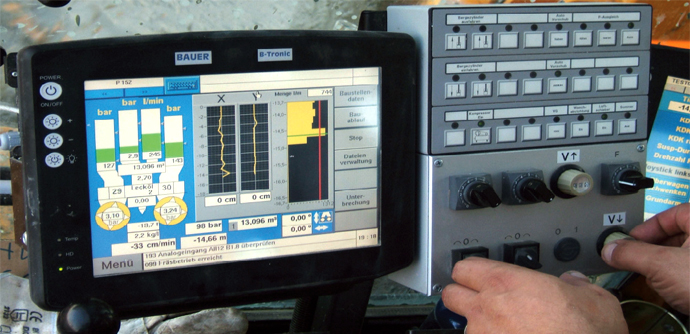 Large Diameter Drilled Shafts
Large Diameter Drilled Shafts Diaphragm wall
Diaphragm wall Hydromill
Hydromill Diaphragm Pile (Barrette)
Diaphragm Pile (Barrette) CFA Piles
CFA Piles Root Piles
Root Piles Tiebacks
Tiebacks Jet Grouting
Jet Grouting Soil Treatment
Soil Treatment Cutter Soil Mixing
Cutter Soil Mixing Soil Improvement
Soil Improvement Environmental Geotechnics
Environmental Geotechnics Large Diameter Drilled Shafts
Large Diameter Drilled Shafts Driving of pre-cast piles
Driving of pre-cast piles Sheet Pile Driving
Sheet Pile Driving  Installation of pipes
Installation of pipes  Foundation for platforms
Foundation for platforms  Deep Shafts (Blind shafts)
Deep Shafts (Blind shafts) Pipeline Insertion System
Pipeline Insertion System
Special Foundations
Offshore Foundations
Oil & Gas
New Technologies
 Cutter Soil Mixing
Cutter Soil Mixing
The In Situ Soil Mixing technique is also known as Cutter Soil Mixing (CSM). Its technological origin was in 1954 in the U.S., where a screw type mixer was used to mix soil and cement.
The deep mixing technique was further developed and was presented for the first time in an international conference in 1975 by two projects, one Swedish, the other Japanese. Deep mixing was very successful in Japan, and the method rapidly evolved after 1980, allowing many companies to fine tune their own versions of the process and to elaborate an extensive variety of techniques.


THE PROCESS CONSISTS OF THE ONSITE CONSTRUCTION OF IMPERMEABLE PANELS, WHERE THE SOIL IS USED AS CONSTRUCTION MATERIAL
The Cutter Soil Mixing (CSM) process consists of the onsite construction of impermeable panels whose geometry is similar to that of a diaphragm wall.
The distinct difference between the Cutter Soil Mixing (CSM) System and other techniques is that there is no soil removed. When working in a contaminated area, the soil is neutralized by the addition of Portland cement or other chemical substances thus saving time and money in transport and treatment at a hazardous treatment facility.
Among the main objectives of the use of the Cutter Soil Mixing (CSM) process in the construction of impermeable panels are:
- Soil structure breakdown;
- Soil and Cement mixing;
- A homogeneous structure consisting of soil and cement.

Learn more about the Cutter Soil Mixing
Specifications, construction sequences, equipments and applications.

